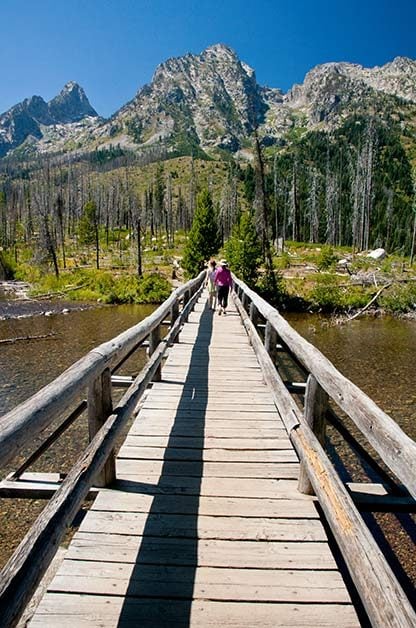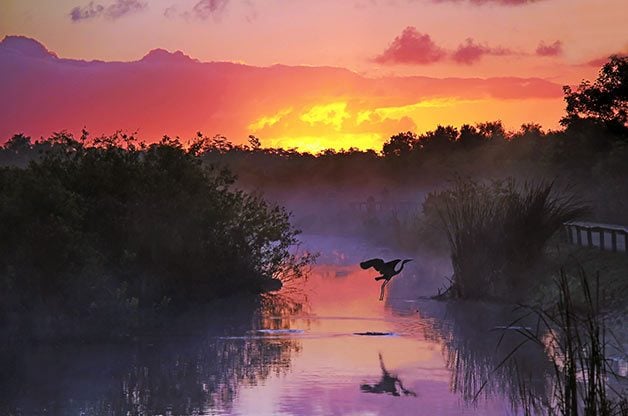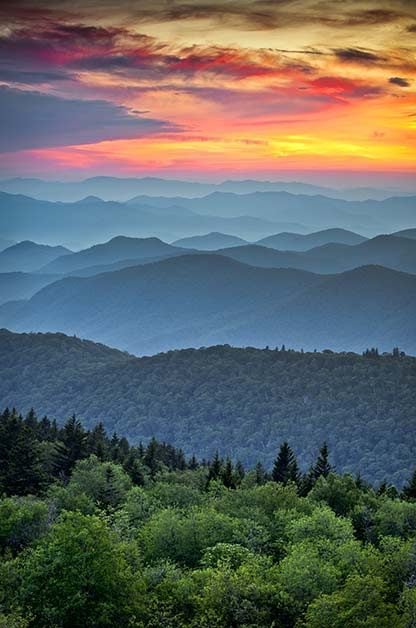10 Spectacular National Park Birding Sites
Updated: Nov. 05, 2020
Fantastic bird sightings are nearly guaranteed when you plan your trip around these magnificent birding hotspots in the National Park system.
Since the establishment of Yellowstone National Park in 1872, the federal government has preserved some of the continent’s most spectacular scenery for the enjoyment of all. With this amazing backdrop of unique habitats, it’s not surprising that you’ll find many top national park birding sites across America. Let’s explore some of the best of the best. Check out 7 awesome facts about national parks.
Big Bend National Park, Texas
With more than 450 documented bird species, Big Bend has recorded more than any other national park. This generous expanse of west Texas covers a wide range of habitats from the banks of the Rio Grande to the rugged Chisos Mountains.
The Colima warbler is a bird that is more common in Mexico, but a few can be found in the mountains of Big Bend. It’s the only place north of the border that the Colima warbler can be found. Other Southwestern species include the hepatic tanager, painted redstart, Scott’s oriole and Mexican jay. Big Bend is also a good place to look for hummingbirds, including the rare Lucifer hummingbird, found more regularly here than anywhere else in the U.S.
These spectacular photographs of America’s national parks will leave you awestruck.
Yellowstone & Grand Teton National Parks, Wyoming

As a Wyoming native, I’ve always had great pride in Yellowstone and neighboring Grand Teton. When I hear the hoarse squawks of the Clark’s nutcracker, I imagine what it was like for the early explorers of the area.
You’ll spot plenty of other creatures with the birds. A couple of my favorite viewing spots are Fishing Bridge and Two Ocean Lake. From the bridge, watch for American white pelicans, river otters, or maybe even a grizzly bear looking to make a snack out of the native cutthroat trout. Another big white bird on the waters of northwest Wyoming is the trumpeter swan, often nesting on Two Ocean Lake. In winter, the swan population grows as migratory birds join the individuals that remain in the region year-round. Fires are an important part of the Yellowstone ecosystem, and I’m always excited to spot woodpeckers and fireweed in areas that were once burned over.
Check out 20 amazing wildlife photos in Yellowstone National Park.

Everglades National Park, Florida
In this vast wetland, mangrove thickets rim freshwater sawgrass prairies, which open out into the salty Atlantic Ocean and Gulf of Mexico. It’s a park best viewed from the water, even if all you have time for is an afternoon paddle. Hiking trails and boardwalks also allow visitors to get prime views of the many species of wading birds, including herons and egrets.
Look for flocks of white ibis foraging in the shallow waters, their long bills probing the mud. You can also find rare wood storks balancing awkwardly in treetops. Roseate spoonbills look unworldly with their pink feathers and spatulate bills. Anhingas sit drying their wings on nearly every available perch. Visitors can also expect to find alligators sunning themselves at water’s edge, so watch where you step.
Check out the 15 best places to camp in national parks.
Acadia National Park, Maine
This expanse of coastal Maine was the country’s first Eastern national park. Whether by car, carriage, bus, bike or boat, it’s worth exploring fully. The scenic vistas along the rugged North Atlantic are impressive enough, but the backdrop of Acadia includes Cadillac Mountain, the highest point on the East Coast.
Nearly two dozen species of warbler have nested in Acadia. Peregrine falcons nest along the rugged cliffs of Precipice Trail, and this is also a noted raptor migration site. Waterfowl include scoters, eiders and guillemots, which congregate during the winter. Be sure to check out the Wild Gardens of Acadia, too, where the diverse plant life can be really active with birds.
Discover the 15 best national park road trips to take all year long.
Great Smoky Mountains National Park, Tennessee and North Carolina

Tucked along the mountains, Great Smoky has more human visitors than any other national park in America. It’s also a popular place for birds and critters. For plants, this is one of the most diverse places on the continent, boasting 100 native tree species and 1,500 kinds of flowering plants.
The park is at a crossroads for birds. Southern species can be spotted in the lowlands, while birds more common in the North inhabit the higher elevations. For example, both Carolina and black-capped chickadees live here. Other Southern highlights include yellow-throated vireos, hooded warblers and Louisiana waterthrush, while Northern birds rare in other parts of the South include golden-crowned kinglets, veery, winter wren, northern saw-whet owls, and black-throated blue, blackburnian, chestnut-sided and Canada warblers. Explore the Great Smoky Mountains to see birds and wildlife.
Point Pelee National Park, Ontario
One of the smallest national parks in Ontario, Point Pelee, at the southernmost tip of Canada, is of critical importance to birds. A peninsula jutting into Lake Erie, it’s like an airport landing strip for many migrating species.
An impressive array of shorebirds, warblers and thrushes move through the park each year. You can also see scarlet tanagers, blue jays and both Baltimore and orchard orioles in good numbers during migration. The area hosts great movements of raptors, too. Some species, like northern harriers, osprey and peregrine falcons, will eventually fly across Lake Erie, but broad-winged, red-tailed and red-shouldered hawks tend to avoid flying over open water. They will generally follow the coast along the western shores of Lake Erie on their southern migration.
With 59 national parks in the U.S. and almost as many in Canada, you could argue that every one of them is a worthy birding destination. So get out there and explore them. You’ll be rewarded with gorgeous scenery, unique habitats and some of the best birding around.
National Seashores and Lakeshores
The National Park Service administers more than 400 units, including monuments, historic sites, recreation areas and scenic trails. National seashores and lakeshores are some of the best birding sites in the national park system. Check out coast to coast birding hotspots for every season.
Cape Hatteras National Seashore
Birding can be phenomenal up and down the Atlantic Coast. This section of North Carolina was the first designated national seashore.
Point Reyes National Seashore
The only national seashore on the Pacific Coast boasts more than 490 bird species—a record for any area administered by the National Park Service.
Padre Island National Seashore
Along the south Texas coast, Padre has more than 70 miles of shoreline and protects the longest stretch of undeveloped barrier island in the world.
Pictured Rocks National Lakeshore
The country’s oldest national lakeshore stretches along the south shore of Lake Superior on Michigan’s scenic Upper Peninsula. Another national lakeshore for birders to explore is Wisconsin’s Apostle Islands.
